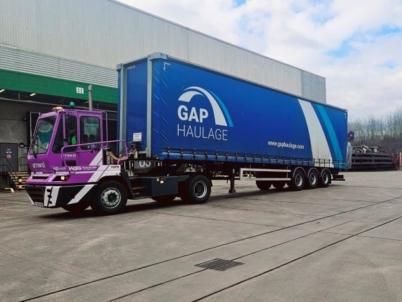-
Nutrivend selects Forterro’s Orderwise to support online expansion and streamline operations - April 11, 2025
-
ARROWXL LAUNCHES AMBITIOUS ZERO WASTE ROADMAP - April 8, 2025
-
THE BCMPA’S NEW CAMPAIGN DRIVES OUTSOURCING SUCCESS IN Q1 - April 7, 2025
-
BLACKOUT TECHNOLOGIES TARGETS TELEMATICS-INTEGRATED MOBILE DEVICE BLOCKING TO COMBAT SMARTPHONE DISTRACTION - April 1, 2025
-
OpenADR Alliance announces first OpenADR 3.0 certified products with EVoke Systems, E.ON Energy and Universal Devices - March 25, 2025
-
Growing fulfilment and contract packer appoints new Managing Director - March 25, 2025
-
When is it time to invest in a WMS? Understanding the key trigger points - March 25, 2025
-
eCapital helps Vantage Recruitment on its journey to financial success - March 24, 2025
-
Hugo Beck Celebrates 70 Years of Packaging Innovation with Open House Events - March 20, 2025
-
PROLOG FULFILMENT SUPPORTS LUNA DAILY’S COMMITMENT TO BETTER BODY CARE FOR ALL WOMEN - March 19, 2025
Fleet maintenance requires an adaptive and agile approach to scheduling. Market demands require a fast flow of goods that often put a strain on operations and result in unexpected breakdowns. Outdated maintenance scheduling systems only compound this stress.
To avoid or at least minimize these pressure-induced risks, it is best to leverage advances in smart maintenance technologies and enhance fleet management with data-driven decision-making. Utilizing cutting-edge tools for your fleet maintenance needs can significantly improve uptime and positively impact your business operations’ efficiency and bottom line.
Integrating digital technologies and software systems for routine inspections and preventive maintenance can enhance vehicle performance, improve safety, and extend the vehicle’s lifespan. The Internet of Things (IoT), artificial intelligence (AI), and fleet telematics are revolutionizing vehicle diagnostics, and you need them to stay ahead of the competition.
Staying Ahead: Best Practices in Fleet Maintenance Scheduling
Here are some of the best practices to adopt in fleet maintenance scheduling that will help keep your fleet in tip-top shape in today’s advanced logistics landscape.
Leveraging Data Integration to Pre-Empt Downtime
It is easier than ever to gain access to large volumes of data that can provide highly useful information like logistics patterns and trends. This can help you more accurately predict delays and disruptions before they happen. Predictive analytics is a powerful tool to develop an efficient fleet maintenance schedule that ensures you the most optimal use of your resources.
Data integration also protects sensitive vehicle data from breaches, providing you with greater information integrity, and resulting in a more reliable basis for maintenance and repair.
The digital age is heavily powered by information, and fleet maintenance is one of the industries gaining more insights from data integration that are crucial to maximizing vehicle uptime. Data-driven decisions will lead to more efficient transportation setups, better load distribution planning, and more precise maintenance schedules.
Optimizing Maintenance Schedules
The use of data for better forecasting involves advanced tools such as automotive digital twin applications. Digital twins are virtual replicas or blueprints of vehicles that can help car manufacturers and users with real-time monitoring, simulating scenarios that lead to breakdowns, remotely testing vehicle performance, and communicating the status to the manufacturer, resulting in more optimized maintenance schedules.
This innovation can help monitor, predict, and simulate various maintenance-related scenarios and fine-tune schedules for maximum efficiency. Furthermore, integrating predictive analytics and machine learning algorithms can enhance the precision of these schedules by analyzing historical data and identifying patterns, leading to proactive and timely maintenance actions.
Training and Skill Development
The synergy of technology and human capital in fleet maintenance has become stronger—understanding new vehicle systems is imperative in effective fleet maintenance scheduling.
There is a need to provide your maintenance team with comprehensive training programs to give them a better understanding of new concepts in automotive wiring diagrams, as well as power electronics, advanced driver assistance systems, and vehicle-to-grid technologies if your fleet includes or is planning to include electric cars.
Covering skills gaps ensures your technicians can adeptly handle and manage any maintenance issues involving old and new vehicle models and systems. With a capable team and optimal mechanic shop organization, your fleet maintenance scheduling and performance could result in better vehicle uptime.
Implementing a Robust Maintenance Management System
As mentioned, the key to more optimized fleet maintenance scheduling is access to data you can leverage for precise planning and execution. Having a robust, tech-driven maintenance management system can save you expenses for repairs, human resources, and potential downtime from unmet client demands and stringent delivery requirements.
One of the most valuable integrations to adopt into your current maintenance management system is fleet telematics. It collects and transmits a range of real-time data on vehicle location and status, deviations from planned schedules, vehicle diagnostics, maintenance issues, traffic situations, driver behavior, fuel efficiency, and more.
These critical vehicle metrics will give you the insights you need to streamline and optimize your fleet maintenance scheduling and overall operations.
Top-Notch Maintenance, Longer Uptime
Whether you’re a fleet owner or a logistics company heavily reliant on third-party services, you will benefit greatly from these best practices and cutting-edge tools for efficient fleet maintenance scheduling. Transitioning from purely manual to digital processes significantly increases the quality of your management system. This, in turn, maximizes vehicle uptime and extends its lifespan, giving you the highest possible returns on your most important assets.
On top of these, speedy and efficient deliveries result in customer satisfaction and enhanced partnerships with suppliers and other providers. These can have a direct impact on your long-term success and business growth. Maintaining peak conditions for your fleet will drive your business forward, so it’s a sound decision to leverage available resources that align with your goals.
Graham Perry is a writer at Business Tech Innovations specializing in logistics supply chain optimization. With expertise in fleet management, freight matching, and transportation technology, his articles empower businesses to navigate the dynamic world of logistics with peace of mind.

































